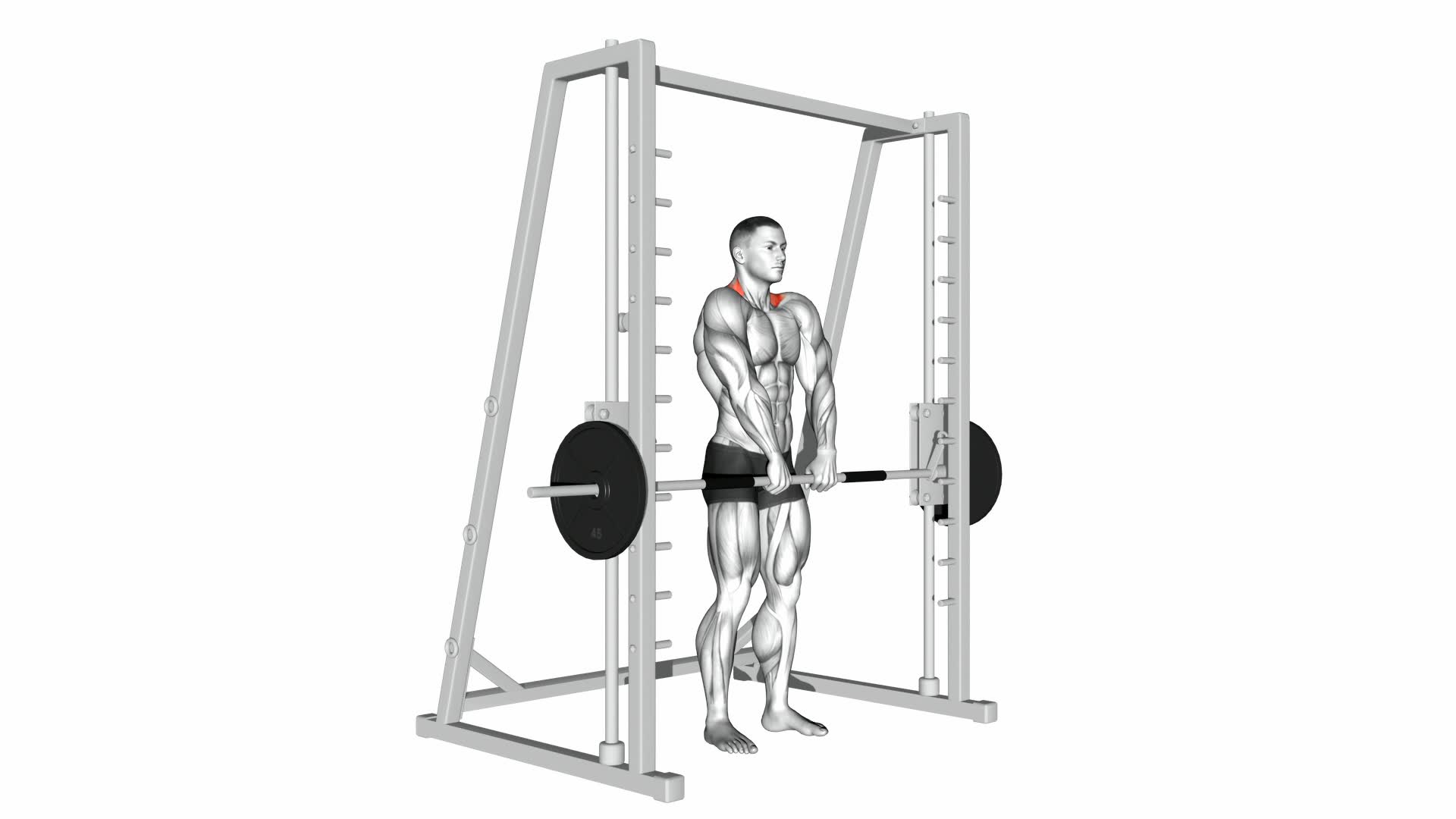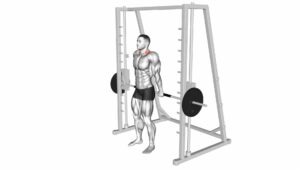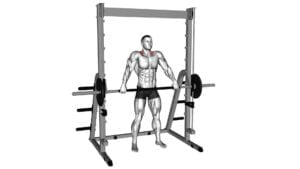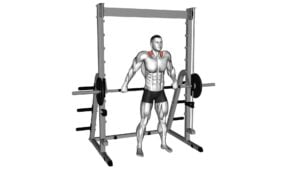Smith Shrug – Video Exercise Guide & Tips

Looking to improve your upper body strength and build impressive shoulder muscles? The Smith Shrug is just what you need.
Watch This Exercise Video
In this video exercise guide, we'll show you the proper form and technique for performing this effective shoulder exercise.
With variations and progressions to challenge yourself, as well as tips for avoiding common mistakes, you'll be on your way to maximizing your results in no time.
So grab the bar and get ready to shrug your way to stronger shoulders!
Key Takeaways
- The Smith Shrug activates and strengthens upper body muscles.
- It targets trapezius muscles for improved posture and shoulder stability.
- The exercise engages deltoids, rhomboids, and erector spinae muscles for balanced development.
- The Smith Shrug is a versatile exercise that can be modified for different fitness levels and goals.
Benefits of the Smith Shrug
You can experience several benefits by incorporating the Smith Shrug into your workout routine. This weightlifting technique is known for its ability to activate and strengthen the muscles in your upper body.
The main muscle group targeted by the Smith Shrug is the trapezius muscle, which runs along the back of your neck and upper spine. By performing this exercise, you can effectively increase the activation and development of your trapezius muscles, leading to improved posture and shoulder stability.
In addition to targeting the trapezius muscles, the Smith Shrug also engages other muscles in your upper body, including the deltoids, rhomboids, and erector spinae muscles. These muscles work together to support proper posture and contribute to overall upper body strength. By incorporating the Smith Shrug into your routine, you can enhance muscle activation in these areas and promote balanced development.
Furthermore, the Smith Shrug is a versatile exercise that can be modified to suit your fitness level and goals. Whether you're a beginner looking to build strength or an experienced lifter aiming to increase muscle size, this exercise can be adjusted to meet your needs.
Proper Equipment Setup
To ensure proper equipment setup for your Smith Shrug exercise, it's crucial to consider two key points: correct chair height and proper monitor position.
First, adjust your chair height so that your feet are flat on the ground and your knees are at a 90-degree angle. This will provide stability and support during the exercise.
Second, position your monitor at eye level to maintain good posture and prevent strain on your neck and shoulders.
Correct Chair Height
Adjust your chair height to ensure proper equipment setup.
Having an ergonomic workspace is essential for posture improvement and overall well-being. When your chair is at the correct height, it allows for optimal alignment of your body. Start by adjusting the height so that your feet are flat on the floor, and your knees are at a 90-degree angle. This helps to relieve pressure on your lower back and promotes better circulation.
Additionally, make sure that your hips are slightly higher than your knees to maintain proper posture. By setting your chair height correctly, you can create a comfortable and supportive environment that promotes good posture and reduces the risk of discomfort or injury.
Proper Monitor Position
Ensure proper equipment setup by positioning your monitor correctly for optimal viewing and posture. To create an ergonomic workspace, consider the following monitor ergonomics:
- Position your monitor at eye level to avoid straining your neck and promote better posture.
- Keep the monitor at arm's length to minimize eye strain and prevent hunching forward.
- Tilt the monitor slightly backward to reduce glare and improve visibility.
By following these monitor ergonomics, you can create a comfortable and productive work environment.
With your monitor in the right position, you can focus on maintaining correct form and technique during your exercises.
Transitioning into the next section, let's explore the importance of correct form and technique to maximize the benefits of the Smith Shrug exercise.
Correct Form and Technique
Use proper technique when performing the Smith Shrug exercise for optimal results. To ensure you're getting the most out of this exercise, it's important to understand and avoid common misconceptions and errors.
One common misconception is that the Smith Shrug primarily targets the traps, when in fact it also engages the rhomboids, deltoids, and upper back muscles. To maximize the benefits, start by standing with your feet shoulder-width apart and your knees slightly bent. Place your hands on the barbell with an overhand grip, slightly wider than shoulder-width apart.
Keep your back straight and your core engaged throughout the exercise. Next, lift your shoulders up towards your ears, squeezing your shoulder blades together at the top of the movement. Lower the barbell back down in a controlled manner, allowing your shoulders to fully relax before starting the next repetition.
It's important to avoid any jerking or swinging motions, as this can put unnecessary strain on your joints and lead to injury. By using proper form and technique, you can effectively target and strengthen your upper body muscles with the Smith Shrug exercise.
Variations and Progressions
Try incorporating different variations and progressions of the Smith Shrug exercise to challenge your muscles and continue making gains. By adding variety to your workouts, you not only keep things interesting, but you also target different muscle groups and stimulate growth in new ways.
Here are some variations and progressions you can try:
- Different grips: Experiment with using different grips during the Smith Shrug exercise. For example, you can try an overhand grip, an underhand grip, or a neutral grip. Changing your grip can help you target different muscles in your shoulders, traps, and upper back.
- Weight increments: Gradually increase the weight you use for the Smith Shrug exercise. By challenging yourself with heavier weights over time, you can continue to build strength and muscle mass. Start with a weight that allows you to perform the exercise with proper form, and then incrementally increase the weight as you become stronger.
- Range of motion: Vary the range of motion during the Smith Shrug exercise to engage different muscle fibers. You can try performing the shrug with a full range of motion, lifting your shoulders up towards your ears, or you can focus on a partial range of motion, keeping the movement more controlled and targeted.
Incorporating these variations and progressions into your Smith Shrug exercise routine can help you break through plateaus and achieve new levels of strength and muscle development. Remember to always listen to your body and adjust the intensity and weight as needed.
Keep challenging yourself and you'll continue to see progress.
Common Mistakes to Avoid
When performing the Smith Shrug exercise, it's crucial to maintain proper form to maximize its effectiveness and prevent injuries. The importance of proper form can't be emphasized enough, as it ensures that you're targeting the intended muscles and minimizing stress on other areas of your body.
To avoid common mistakes, focus on maintaining a neutral spine, engaging your shoulder blades, and using a controlled and smooth motion throughout the exercise.
Proper Form Importance
Ensure proper form while performing the Smith Shrug exercise to maximize results and avoid common mistakes. The importance of technique can't be overstated when it comes to this exercise. By maintaining proper form, you not only reduce the risk of injury but also ensure that the targeted muscles are being activated effectively.
Here are a few key points to keep in mind:
- Keep your feet shoulder-width apart and your knees slightly bent to maintain stability and balance.
- Engage your core muscles throughout the exercise to stabilize your body.
- Avoid using excessive weights that compromise your form and prevent proper muscle activation.
Injury Prevention Techniques
Practice proper technique to prevent injuries while performing the Smith Shrug exercise. Injury prevention starts with an ergonomic workstation setup.
Ensure that your workstation is set up correctly, with your chair at the right height and your computer monitor at eye level. This will help maintain proper posture and reduce the risk of strain on your neck and shoulders.
Additionally, before starting any exercise, it's important to do stretching and warm-up exercises. These exercises help increase blood flow to the muscles, improve flexibility, and reduce the chance of injury.
Take a few minutes to stretch your neck, shoulders, and upper back before performing the Smith Shrug exercise.
Tips for Maximized Results
To maximize your results, incorporate the Smith Shrug exercise into your routine. This exercise targets your trapezius muscles, helping to build strength and definition in your upper back and shoulders. By adding the Smith Shrug to your workout, you can take advantage of the following tips for maximizing gains and effective workout strategies:
- Focus on proper form: Ensure that you maintain a neutral spine and engage your core throughout the exercise. This will help you avoid injury and ensure that you're targeting the intended muscles.
- Gradually increase weight: Start with a weight that challenges you but allows you to perform the exercise with proper form. As you become stronger, gradually increase the weight to continue progressing and stimulating muscle growth.
- Incorporate progressive overload: To maximize your gains, gradually increase the intensity of your workouts over time. This can be achieved by increasing the weight, the number of sets and repetitions, or reducing rest time between sets.
Frequently Asked Questions
Can I Perform the Smith Shrug Exercise Without Using a Smith Machine?
Yes, you can perform the Smith shrug exercise without using a Smith machine. There are alternative exercises you can do to target the same muscles.
However, it's important to note that using a Smith machine has its benefits, such as providing stability and control during the movement.
If you don't have access to a Smith machine, you can try dumbbell shrugs or barbell shrugs to work your traps effectively.
How Many Sets and Repetitions Should I Do for the Smith Shrug Exercise?
To perform the Smith shrug exercise effectively, it's important to know the number of sets and repetitions. For optimal results, aim for 3 to 4 sets of 8 to 12 repetitions. This will help target your traps and build strength in that area.
Remember to maintain proper form throughout the exercise to avoid any potential injuries.
Now, let's dive into the Smith Shrug – Video Exercise Guide & Tips {076712} for more detailed instructions.
Can I Incorporate the Smith Shrug Exercise Into a Full-Body Workout Routine?
Yes, you can definitely incorporate the smith shrug exercise into a full-body workout routine. Incorporating smith shrugs into your routine can provide numerous benefits for overall strength and muscle development.
This exercise specifically targets the trapezius muscles in your upper back and shoulders, helping to improve posture and upper body strength.
Is It Necessary to Use a Weightlifting Belt While Performing the Smith Shrug Exercise?
Using a weightlifting belt during the Smith shrug exercise isn't necessary. However, it can provide extra support and stability to your lower back.
When performing the exercise, using dumbbells instead of a barbell can offer added benefits. Dumbbells allow for a greater range of motion, targeting the muscles in your upper back more effectively.
To avoid common mistakes, maintain proper form by keeping your back straight and shoulders relaxed throughout the movement.
Can the Smith Shrug Exercise Help Improve My Posture?
The Smith shrug exercise can be a great addition to your daily routine if you want to improve your posture. By targeting the muscles in your upper back and shoulders, this exercise helps to strengthen and stabilize these areas, which can lead to better posture over time.
To maximize the benefits, it's important to focus on correct form and technique. Keep your shoulders relaxed, lift the barbell straight up, and squeeze your shoulder blades together at the top of the movement.
Conclusion
In conclusion, the Smith shrug exercise offers numerous benefits for strengthening and developing the upper traps and shoulders. By following the proper equipment setup, maintaining correct form and technique, and incorporating variations and progressions, you can maximize your results.
Avoiding common mistakes and implementing these tips will help you achieve your fitness goals effectively. Incorporate the Smith shrug into your workout routine for improved upper body strength and posture.

Author
Years ago, the spark of my life’s passion ignited in my mind the moment I stepped into the local gym for the first time. The inaugural bead of perspiration, the initial endeavor, the very first surge of endorphins, and a sense of pride that washed over me post-workout marked the beginning of my deep-seated interest in strength sports, fitness, and sports nutrition. This very curiosity blossomed rapidly into a profound fascination, propelling me to earn a Master’s degree in Physical Education from the Academy of Physical Education in Krakow, followed by a Sports Manager diploma from the Jagiellonian University. My journey of growth led me to gain more specialized qualifications, such as being a certified personal trainer with a focus on sports dietetics, a lifeguard, and an instructor for wellness and corrective gymnastics. Theoretical knowledge paired seamlessly with practical experience, reinforcing my belief that the transformation of individuals under my guidance was also a reflection of my personal growth. This belief holds true even today. Each day, I strive to push the boundaries and explore new realms. These realms gently elevate me to greater heights. The unique combination of passion for my field and the continuous quest for growth fuels my drive to break new ground.







